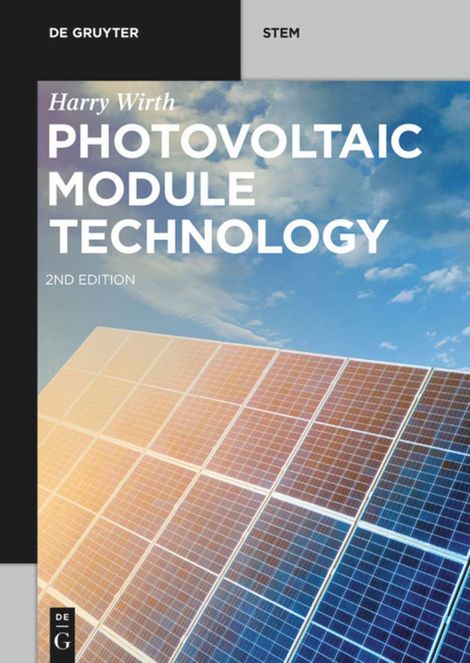Photovoltaic Module Technology, 2nd Edition
By Dr. Harry Wirth

Contents
Preface V
Symbols and units XI
1 Introduction 1
2 Solar cell properties 11
2.1 Types of solar cells 13
2.2 IV parameters and the electric model 14
2.2.1 IV curve 15
2.2.2 One-diode model 17
2.2.3 Deriving circuit parameters from measured IV curves 23
2.2.4 Two-diode model with reverse breakdown 26
2.3 Cell efficiency 27
2.4 Spectral response 30
2.5 Temperature coefficients for cell power 34
2.6 Low-light response 34
2.7 Formats and mechanical properties 35
2.8 Thermo mechanical properties 37
2.9 Cell metallization and contact pads 38
2.9.1 Front-to-back contact cells 38
2.9.2 Back contact cells 42
2.10 Antireflective texturing and coating 43
3 Module design, materials, and production 47
3.1 Cell interconnection 50
3.1.1 Ribbons and wires 50
3.1.2 Structured interconnectors 53
3.1.3 Conductive backsheet 56
3.1.4 Cell shingling 57
3.1.5 Soldering processes 58
3.1.6 Solders 61
3.1.7 Electrically conductive adhesives 67
3.1.8 Joint characterization 69
3.2 Covers and encapsulants 72
3.2.1 Front cover 72
3.2.2 Rear cover 79
3.2.3 Encapsulants 82
3.2.4 Edge sealed designs without encapsulant 87
3.2.5 Laminate characterization 88
3.3 Junctions and frame 91
3.4 Module production 95
3.4.1 Production process 95
3.4.2 Production equipment 96
3.5 Module recycling 102
4 Basic module characterization 105
4.1 Light IV measurement 105
4.2 Energy rating 110
4.3 Dark IV measurement 111
4.4 Electroluminescence imaging 112
5 Module power and efficiency 115
5.1 IV parameters and electric model 115
5.2 Partial shading and hot spots 116
5.3 Power and efficiency model 118
5.4 Geometrical effects 122
5.5 Optical effects 123
5.5.1 Air/glass and glass/encapsulant interface reflection (f1, f3) 124
5.5.2 Glass and encapsulant bulk absorption (f2, f4) 126
5.5.3 Active area interface reflection (f5) 128
5.5.4 Active area multiple reflection (f6) 129
5.5.5 Finger multiple reflection (f7) 130
5.5.6 Cell interconnector shading and multiple reflection (f8) 132
5.5.7 Cell-spacing multiple reflection (f9) 135
5.6 Electrical effects 138
5.6.1 Cell mismatch (f10) 138
5.6.2 Series resistance losses (f11, f12, f13) 138
5.7 Comprehensive model 141
6 Module performance 145
6.1 Irradiation models 147
6.2 Temperature effects 151
6.3 Irradiance level 153
6.4 Irradiance angle 153
6.4.1 Incidence angle modifiers 153
6.4.2 Angular distribution of radiation 156
6.5 Irradiance spectrum 158
6.6 Bifacial performance 158
6.7 Energy payback 161
7 Module cost 163
References 169
Index 175
Preface
In December 2015, the United Nations Climate Change Conference in Paris sent a clear signal for a worldwide energy transition toward renewables, a transition to take place long before total consumption of fossil and nuclear resources and timely before catastrophic climate change. Photovoltaic (PV) technology, the direct conversion of solar energy into electricity, is becoming the main pillar of our sustainable energy supply. Its impressive rise has been enabled by a cost reduction momentum not foreseen two decades ago even by its most optimistic supporters. Meanwhile, new, large-scale PV has become the cheapest electricity supply in many parts of the world. Lowest bids promise to provide electricity at 1.5–2 ct(€)/kWh in different sunny regions of the world, including southern Europe. The price learning curve will keep progressing, since many innovations are well underway in all parts of the value chain.
PV modules are the key components for every PV power plant from tiny rooftop systems of a few kilowatts up to plants in the gigawatt range which may demand millions of modules. Modules are required to efficiently and safely convert solar irradiance into electric power over a service life of 25–30 years. This book addresses crystalline silicon, wafer-based module technology capable of fulfilling these expectations. A proper module design and choice of materials is based on a thorough understanding of a variety of solar cell properties. With these specifications and boundary conditions in mind, module material, components and manufacturing issues are elaborated, focusing the key steps of cell interconnection and encapsulation. The cell-to-module (CTM) loss and gain mechanisms in power and efficiency are discussed in detail, since they are crucial for optimizing the product. CTM analysis is the key for understanding recent innovations in module technology like halfcells, multiwire interconnection, and shingle interconnection. After considering nominal module properties displayed under standard testing conditions, module performance in the field under varying ambient conditions is tackled. Finally, the cost structure of PV modules and its implication on the cost of PV power plants and ultimately of PV electricity are examined.
The author thanks his colleagues at the Fraunhofer Institute for Solar Energy Systems ISE in Freiburg, Germany, for many valuable discussions and generous contributions to this book from their various R&D projects.
Harry Wirth
